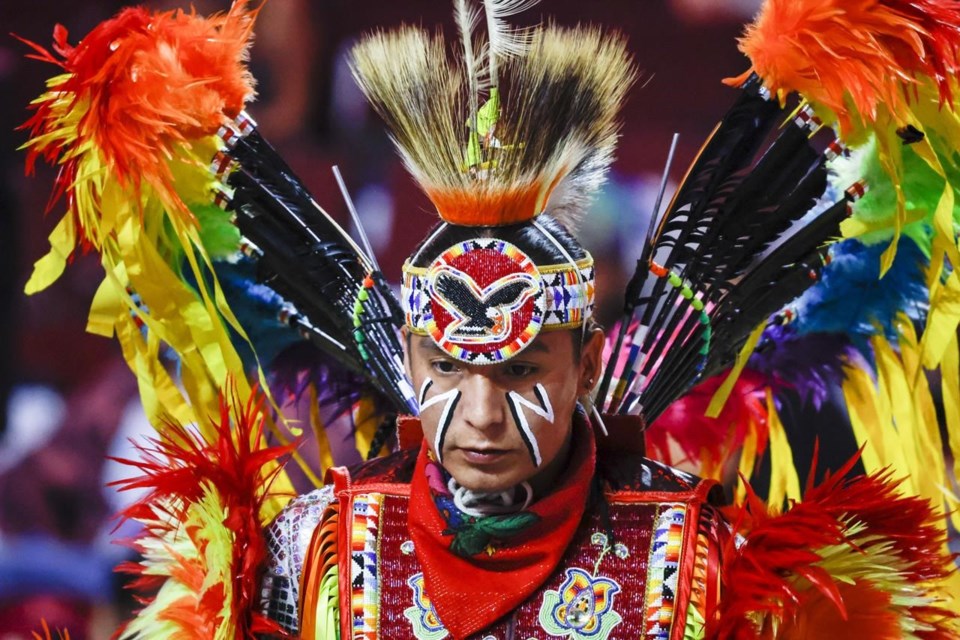CALGARY — Men sit around large drums along the edges of the arena. Each group takes a turn drumming and singing.
The drum, described as the heartbeat of Mother Earth, provides rhythm for dancers in traditional regalia as they compete in Indigenous dances, including the men's chicken, the men's and women's fancy and the women's jingle.
Stampede-goers gather in seats normally filled by those watching concerts or sports games.
"This is the first powwow that we're hosting here at the Saddledome," Cheryl Crowchief, co-ordinator of the Calgary Stampede Powwow, said in an interview this week.
The Scotiabank Saddledome, named for its saddle-shaped roof, is home to the Calgary Flames of the National Hockey League, the Calgary Hitmen in the Western Hockey League and the Calgary Roughnecks with the National Lacrosse League.
Crowchief said there is a powwow competition at Elbow River Camp, a village on the Stampede grounds that highlights local First Nations' cultures.Â
"But this year we brought it to the Saddledome and are hoping that the success we had at the village comes over here."
Crowchief said the larger venue allows more people to see some of the world's best powwow dancers and drummers.
"This is top, top, top people everywhere," she said. "We have people participating in the powwow from the United States, from all over ÎÚÑ»´«Ã½. It has gone worldwide."
The powwow started Tuesday and ends Thursday, as 20 dancers remaining in each category compete for a place in the top 10 and a cash prize. A total of $175,000 in prizes are to be handed out.
Some dancers said it's exciting to be back at a powwow after two years of COVID-19 public health measures. Some also expressed nervousness to be competing in such a large event.
Charles Woods, a senior men's traditional dancer from Siksika Nation, east of Calgary, said he's happy to be dancing again.
"It's a feeling that nobody can explain," he said. "The drum beats and the songs that are sung are very, very good healing songs. It's an uplift. The drum is the heartbeat of Mother Earth. When we dance, we dance to those songs."
Some competitors said being in the large arena, while much cooler than outside in the heat, is also a bit stressful.
"It's pretty nerve-racking," said Teagan Rabbit Carrier, also from Siksika Nation, who was competing in the junior contemporary jingle dance. "I am nervous, but I am here for a good time and to bring healing to my community."
Her regalia included a shimmering yellow dress and a colourful beaded headband.
"My Aunty Dawn ... made this outfit for me. I wanted a yellow dress so she made it sparkly," she said. "I have a green ribbon at the back of my dress to represent my late brother, Kristian Ayoungman, and my Aunty Gaylene."
Raylene Hunter, a senior women's traditional dancer from Onion Lake Cree Nation in Saskatchewan, said her family competes across ÎÚÑ»´«Ã½ and the United States and travels internationally to teach people about Indigenous culture.
She said it is her first time at the Stampede powwow.
"It's a little bit stressful ... but it's really exciting."
Hunter, who lives in Edmonton, said powwows are an important part of her culture but also play a role in her parenting style.
"My children learn that there's a way to conduct yourself when you are wearing these feathers, when you are wearing your regalia — to look after it," she said. "Those values that come with teaching your kids on how to respect themselves, how to respect what they are wearing and also just to respect themselves as women — to be mindful of what type of your environment and what kind of setting you are in.
"So, you are teaching them patience ... you are teaching them discipline. There are all kinds of values that come with teaching your kids on how to be the best person that you can possibly be — in or out of your outfit."
Hunter said powwow regalia also provides strength.
"My husband always says, 'When I put on my outfit, I feel like I'm my true warrior self,'" she said. "That's the same for women as well. When we put on our outfit, we are warrior women. We are protectors of our children, of our families, of our home fires."Â
Crowchief said powwows are an important part of Indigenous heritage.
"It's our way here in traditional Treaty 7 area to show people our culture, to share our culture and to educate," she said. "A powwow for us is a celebration, it's not a ceremony.
"It's a way for us to get together and celebrate life, celebrate the changing of the seasons, celebrate our kids. It's a family gathering to invite non-Indigenous people to join us and celebrate with us."
This report by The Canadian Press was first published July 14, 2022.
Colette Derworiz, The Canadian Press



